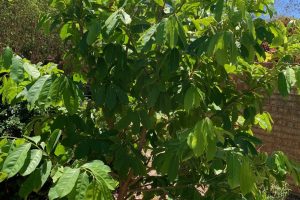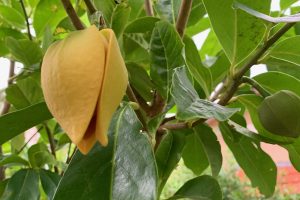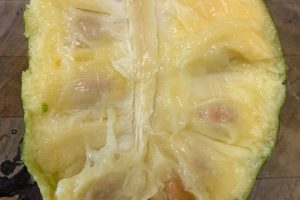Annona montana
Guanabana, mountain soursop, wild custard apple
Origin
Indigenous to meso-America and not well known elsewhere.
Climate
Wet and dry tropical regions from sea level to 700m in its native areas, but it also grows in dry and moist sub-tropical climates. Optimum mean annual temperatures are 21 – 26°C, with annual precipitation of 100-600mm. It can withstand some dry periods, is much more cold tolerant than soursop, and can tolerate brief exposure to freezing temperatures.
Plant Description
An evergreen tree (semi-deciduous in cooler regions) up to 4-8m high, spreading crown and rough dark grey-brown bark. The taproot is not pronounced and only achieves any depth in light soils. The glossy leathery leaves have a short petiole and are alternate, glabrous, dark green above, pale below, 7-16 X 2-7cm and oblong-ovate. They contain oil and mucilage cells.
Relatives
Taxonomic classification of the Annonaceae family remains uncertain with too little research conducted, but currently there are 108 genera and around 2400 species, with >162 species in Annona. Fruiting relatives are sugar apple, soursop, custard apple, atemoya, ilama, posh-te, pond apple and cherimoya.
Soils
Guanabana is not fussy regarding soil types, growing in sandy to clay loams; it tolerates a pH range of 5.8 -8 but does best at 6 – 6.5. Higher yields are obtained in more well-drained soils, with drainage being essential to avoid root rots.
Propogation
By seeds planted as soon as possible. At temperatures of 20, 25, 30 and 35°C, germination success averages 0, 55, 25 and 0% respectively. Increased cold tolerance for soursop (which prefers tropical climates) can be achieved by grafting onto guanabana rootstocks.
Cultivars
Domesticated plants are all wild selections as no breeding work has been done.
Flowering and Pollination
Slightly scented fleshy flowers are solitary or in fascicles of 2-4 with stout peduncles, mainly on new growth but sometimes on older branches. There are 3 small green sepals, 6 petals in two whorls with the inner three forming a pollination chamber, numerous crowded spirally-arranged stamens in a rounded mass, and an upper conical-shaped dome of numerous carpels with one ovule each. There is no nectary. The flowers are thermogenic ie warmer than ambient temperature, and exhibit protogynous dichogamy with temporal separation between pistillate and staminate phases that may extend over 2 days, meaning pollination within flowers is not the rule. No chilling period is required. Whole tree flowering may extend over a number of months, and high humidity in this period (either naturally or by under-tree sprinkling/misting) minimises desiccation of stigmas and improves productivity. Pollination is by nocturnal scarab beetles attracted by the female stage odour; flies may also visit flowers but without strong evidence for pollination. Hand pollination improves fruit set and size.
Cultivation
Only wild plants are harvested in native areas, with some selection of the better ones spared from clear-felling and other agricultural needs. It thrives in full sun and heavy shading will reduce fruit set. Uniform soil moisture content is desired as extremes will lower production. There is a high demand for K.
Wind Tolerance
The soft wood makes them susceptible to wind damage and limb breakage. Wind may also cause fruit rubbing.
Pruning
In vigorous trees, light penetration to the base can be <5%, so an open vase shape is desirable. The usual practice of pruning off crossing branches and skirting should be conducted.
The Fruit
The fruit is a syncarp, formed by the fusion of numerous carpels. It is globose to oval, 15-25 X 10–15cm, and has a green skin covered with soft, 3 mm-long spines. The colour may lighten with ripening. The white-yellowish pulp is sub-acid and fibro-mucilagenous with a strong aroma, and contains numerous light brown, oblong seeds, 12-18 mm long.
Fruit Production and Harvesting
Plants may begin fruiting when only 3-4 years old. If there are insufficient pollinators, fruit set may be compromised and fruit could be small and asymmetric; fruit size depends on the number of ovules fertilised. Fruit can ripen throughout much of the year, but mainly during autumn and winter.
Fruit Uses
The climacteric fruit are eaten fresh and made into juices. Generally the flavour is inferior to soursop, but as plants are inevitably open-pollinated heterogeneous seedlings there is considerable variation in fruit properties; a minority can be pleasant. Fruit are quite perishable and ripe storage life is short.
Pests and Diseases
Not known but could be similar to other Annonas ie anthracnose, black canker, diplodia rot and bacterial wilt, Medfly, mealy bugs and scale insects. Weed competition should be controlled.
Comments
As a more cold-hardy species than many others in the genus, there should be little problem growing this plant in the Perth surrounds. You may be lucky with your seedling if it has a pleasant taste, but if not, you could use it as a rootstock to confer greater cold-hardiness on more tropical species in the genus that would otherwise struggle here.



